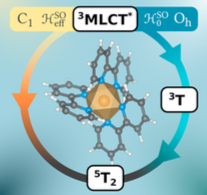Effect of Second-Order Spin-Orbit Coupling on the Interaction between Spin States in Spin-Crossover Systems
Effect of Second-Order Spin-Orbit Coupling on the Interaction between Spin States in Spin-Crossover Systems
C. Sousa, A. Domingo, C. de Graaf.
Chem. Eur. J., 23 (2017) 1.

Inclusion of second-order spin-orbit coupling and geometrical distorsions
explains the mechanism of the light-induced spin crossover
The second-order spin-orbit coupling is evaluated in two transition-metal complexes to establish the effect on the deactivation mechanism of the excited low-spin state in systems that undergo spin transitions under the influence of light. The combined effect of geometry distortions and second-order spin-orbit coupling leads to sizeable interactions for states that are nearly uncoupled in the symmetric (average) structure of the complex. This opens the possibility of a direct deactivation from the singlet and triplet states to the metal-to-ligand charge-transfer manifold and to the final high-spin state as suggested from the interpretation of experimental data but so far not supported by theoretical descriptions of the light-induced spin crossover.
